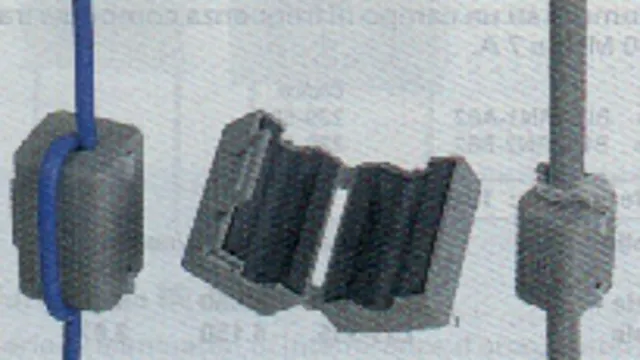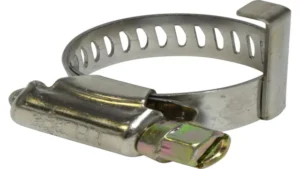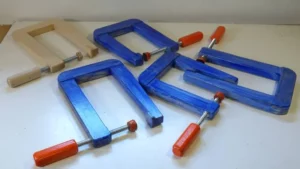Have you ever experienced strange interference in your electronics, causing your TV or computer to produce white noise or other unpleasant sounds? If you have, then you’re probably dealing with electromagnetic interference (EMI). EMI is a phenomenon where electromagnetic waves produced by one device interfere with the workings of another device in close proximity. You may not know this, but one effective solution for avoiding EMI is to use ferrite clamps.
Ferrite clamps (also known as ferrite cores) are small, toroidal-shaped devices that are made of magnetic material. They’re designed to absorb or suppress EMI completely, by acting as a filter between your electronic devices and other electromagnetic waves. However, knowing where to place ferrite clamps can be daunting.
That’s why we have put together a comprehensive guide on where to place ferrite clamps, to ensure you get the most from your devices. In this guide, we will be discussing what ferrite clamps are, the types of EMI they can suppress, and the key locations where they should be placed for optimal results. We’ll also be discussing the different types of ferrite clamps, their applications, and how to use them to best effect.
So, if you’re tired of dealing with EMI in your electronics and want to put an end to the interference, read on. Our guide will provide you with all the information you need to place ferrite clamps on your electronic devices correctly. With our help, you’ll be able to get the most out of your gadgets without any disruptions or distractions.
What are Ferrite Clamps?
Ferrite clamps are electrical devices used to suppress high-frequency electromagnetic interference (EMI) on cables. These clamps are made of ferrite, a material that absorbs EMI and prevents it from passing through cables and other conductive materials. So, where to put ferrite clamps? Well, the answer depends on the type of cable you’re working with and the sources of EMI in your environment.
Generally, you should place ferrite clamps as close as possible to the source of EMI or at any point where the cable enters or exits a device. This will help to mitigate any potential EMI disturbances and ensure that your cables are performing their best. Ferrite clamps are easy to use and can provide significant benefits in terms of reducing errors, improving signal quality, and increasing overall system reliability.
So, if you’re working with sensitive electronics, it’s worth considering adding ferrite clamps to your toolkit.
Definition and Purpose of Ferrite Clamps
Ferrite clamps are widely used in electronic equipment to suppress high-frequency electromagnetic interference (EMI) caused by electromagnetic radiation. They are a type of ferrite core that encircles the wire and works by absorbing the EMI energy through the ferrite material’s magnetic field. Ferrite clamps are easy to install and are an inexpensive solution for reducing high-frequency noise.
The purpose of ferrite clamps is to prevent electromagnetic interference from disrupting the performance of electronic devices, which can lead to data loss or equipment malfunction. Ferrite clamps are commonly used in computer cables, power cords, and audio cables to prevent signal loss or degradation. They are available in a variety of sizes, shapes, and materials to match different cable diameters and applications.
In summary, ferrite clamps are an essential component in electronic devices to ensure proper performance and prevent EMI from interfering with signal transmission or equipment function.

Different Types of Ferrite Clamps
Ferrite clamps are devices used for electromagnetic interference suppression in electronic devices. They are made of a type of ceramic material known as ferrite, which can absorb and dissipate electromagnetic interference. The clamps are designed to be attached to cables, wires, or other conductors to reduce the amount of electromagnetic radiation that can be emitted by these devices.
There are different types of ferrite clamps depending on their applications. One type is the split clamp, which is designed for easy installation without the need to remove or disconnect any cables. They consist of two halves held together by a screw that can be tightened around the cable.
Another type is the closed clamp, which requires the cable to be threaded through the clamp before installation. These clamps offer better interference suppression than split clamps as they provide better protection against the interference. Lastly, snap-on ferrite clamps are easy to install as they can be snapped onto the cable without the need for disconnection.
They are also the most common type of ferrite clamp that is used in a wide range of electronic devices such as computers, televisions, and other home appliances. In summary, ferrite clamps are very important in providing a stable electromagnetic environment in electronic devices free from interference that can affect their proper functioning.
Where to Place Ferrite Clamps?
Ferrite clamps play a crucial role in preventing electromagnetic interference in electronic devices. Proper placement of these clamps ensures maximum efficiency in reducing noise and improving the quality of the signal. But where exactly should one place ferrite clamps? The answer lies in identifying the source of the interference.
Ferrite clamps should be placed as close as possible to the source of the noise. This could be a cable or wire that is carrying the signal. Placing the clamp near the source of the interference can help prevent it from spreading and disrupting other components in the device.
It is also important to ensure that the clamp is securely fastened around the cable or wire, as loose clamps may not be effective in reducing interference. Proper placement and secure attachment of these clamps can go a long way in improving the overall performance of electronic devices.
Common Locations for Ferrite Clamps
Ferrite clamps are a useful tool when it comes to reducing electromagnetic interference in electrical circuits. But where should you place them for optimal results? The most common locations for ferrite clamps are on cables, wires, and cords that emit electromagnetic radiation. This includes power cables, USB cables, HDMI cords, audio cables, and Ethernet cables.
Essentially, any cable that connects to an electronic device has the potential to create electromagnetic interference and therefore, benefit from the application of ferrite clamps. In addition to cables, ferrite clamps can also be placed on antennas, where they can reduce the amount of interference that is generated by the antenna. This is particularly useful in radio and television broadcasting where it is essential to ensure signal quality.
Ferrite clamps can also be placed on electronic devices themselves, for example, on computer cases or video game consoles. This can help to reduce the amount of electromagnetic interference that is generated by the device and subsequently, reduce the risk of interference with nearby electronic equipment. Overall, the placement of ferrite clamps will depend on the type of electronic device and the cables or cords associated with it.
However, by identifying the locations that are most likely to generate electromagnetic interference, it is possible to strategically apply ferrite clamps to reduce this interference and improve overall performance. So don’t be afraid to experiment with the placement of ferrite clamps on your electronic devices and cables, as the benefits of reduced interference can be significant.
Factors to Consider When Placing Ferrite Clamps
Ferrite clamps are essential for reducing electromagnetic interference (EMI) in electronic devices. However, the placement of these clamps is crucial in ensuring their effectiveness. One factor to consider when placing ferrite clamps is the location of the EMI source.
The clamps should be placed as close as possible to the source of EMI to reduce the noise it generates. Another factor to keep in mind is the frequency of the EMI. Different ferrite clamps are designed to work at specific frequencies, so it is important to choose the appropriate clamp for the frequency range of the EMI.
Additionally, the size and shape of the cables or wires play a role in determining where to place the clamps. The thicker the cable, the more clamps may be needed, and they should be spaced out evenly along the cable. Finally, it is essential to avoid placing ferrite clamps near sensitive electronic components, as they could cause unintended interference.
By considering these factors, you can optimize the placement of ferrite clamps for maximum EMI reduction in your electronic devices.
Tips for Proper Placement of Ferrite Clamps
Ferrite clamp placement When it comes to properly placing ferrite clamps, it’s important to consider the purpose of the clamp and the type of cable or wire it’s being attached to. The general rule is to place the clamp as close to the source of electromagnetic interference (EMI) as possible. This could mean placing it near the equipment generating the EMI or near the cable/wire that’s experiencing interference.
It’s important to note that ferrite clamps may not always be necessary and could potentially interfere with the functioning of the cable or wire if placed incorrectly. It’s best to consult with a professional or refer to the manufacturer’s instructions before attaching ferrite clamps. In addition to placement, it’s also important to choose the right size and type of ferrite clamp for the job.
Ferrite clamps come in various shapes and sizes, and selecting the wrong one could lead to poor performance or damage to the cable or wire. Overall, ferrite clamp placement should be a strategic decision based on the specific circumstances of the equipment and cables/wires involved. With proper placement and selection, ferrite clamps can effectively reduce EMI and improve overall performance.
Benefits of using Ferrite Clamps
If you’re wondering where to put ferrite clamps, the answer is simple: near any electronic device that produces high-frequency signals. Ferrite clamps, also known as ferrite cores, are small magnetic rings used to suppress high-frequency electromagnetic interference (EMI) that can disrupt the functionality of other nearby electronic devices. By placing ferrite clamps near cables and wires that carry high-frequency signals, you can improve the overall performance of your devices.
Ferrite clamps are easy to install and inexpensive, making them an excellent investment for anyone looking to improve the quality of their electronic devices. Whether you’re a casual user or a professional, ferrite clamps are an essential tool that can help you get the most out of your electronics.
Improved Electrical Performance
Ferrite clamps are an excellent solution for improving electrical performance in a variety of applications. These small, cylindrical devices are made from ferrite, a material that is highly effective at reducing electromagnetic interference (EMI) and noise. By placing a ferrite clamp around a cable or wire, you can greatly reduce the amount of stray RF signals that can travel along the cable, which in turn can lead to better overall performance and reliability of the system.
Ferrite clamps can help to improve signal integrity, reduce noise levels, and minimize the risk of interference or cross-talk between different components. Whether you’re working on a complex electronics project or simply looking to improve the performance of a basic home theater system, ferrite clamps are an excellent tool to have in your arsenal. So if you’re looking to take your electrical performance to the next level, consider incorporating ferrite clamps into your designs and projects.
Reduction of EMI and RFI Interference
Ferrite clamps can be incredibly beneficial for individuals looking to reduce EMI and RFI interference. These clamps work by reducing the amount of electromagnetic radiation that a circuit emits, thereby eliminating any interference that might occur. Ferrite, which is a type of magnetic material, is often used to construct these clamps.
Ferrite has a unique property that allows it to absorb electromagnetic radiation, making it an ideal material for use in these types of applications. By using ferrite clamps, individuals can ensure that their circuits run smoothly without any interference from unwanted radiation. Whether in a commercial or home setting, these clamps can provide significant benefits to individuals seeking to improve the performance and reliability of their electronic devices.
Conclusion: Ferrite Clamps Improve Electrical Performance and reduce Interference
In conclusion, when dealing with electronic cables, ferrite clamps are the unsung heroes that can make all the difference in reducing electromagnetic interference. Whether you’re dealing with a PC, TV or any other electronic device, the perfect placement of ferrite clamps will ultimately depend on the specific cable and the environments it will be operating in. So, when in doubt, remember this simple rule: clamp it like it’s hot, and you’ll be sure to get optimal performance and minimal interference.
“
FAQs
What are ferrite clamps and their purpose?
Ferrite clamps are devices made of a ferrite material that are used to reduce high-frequency noise and interference in electronic circuits.
Where should ferrite clamps be placed in a circuit?
Ferrite clamps should be placed as close as possible to the source of the interference or noise in the circuit.
How do ferrite clamps work?
Ferrite clamps work by absorbing high frequency electromagnetic interference and converting it into heat, which is then dissipated.
How many ferrite clamps are needed in a circuit?
The number of ferrite clamps needed in a circuit depends on the level of interference and the length of the circuit. In general, one or two clamps should be sufficient.
Can ferrite clamps be reused?
Ferrite clamps can be reused as long as they are not damaged or cracked. They should be checked regularly for any signs of wear and tear.
What is the difference between a ferrite bead and a ferrite clamp?
Ferrite clamps are typically used to reduce EMI in cables or wiring, while ferrite beads are used to suppress high-frequency noise in electronic components like capacitors or inductors.
Are there different types of ferrite clamps?
Yes, there are different types of ferrite clamps available, including split-core, snap-on, and clip-on clamps, each designed for different applications and installation methods.






